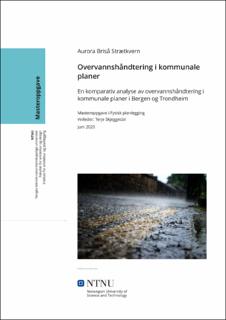| dc.contributor.advisor | Skjeggedal, Terje | |
| dc.contributor.author | Strætkvern, Aurora Briså | |
| dc.date.accessioned | 2023-05-15T17:19:32Z | |
| dc.date.available | 2023-05-15T17:19:32Z | |
| dc.date.issued | 2020 | |
| dc.identifier | no.ntnu:inspera:61011323:5704242 | |
| dc.identifier.uri | https://hdl.handle.net/11250/3068008 | |
| dc.description.abstract | Denne oppgavens hensikt er å undersøke i hvilken grad dagens planverk gir kommuner tilstrekkelig adgang til å implementere klimatilpasset overvannshåndtering. Det forventes et større nedbørsvolum og økt hyppighet av potensielt ødeleggende overvannshendelser. Økt urbanisering og økt nedbør grunnet klimaendringer er de viktigste årsakene til dette. Nasjonale retningslinjer pålegger kommunene å planlegge for at overvann skal håndteres lokalt og i åpne løsninger, slik at man unngår overbelastning av avløpsnettet og forhindrer flomhendelser som gir materielle og økonomiske skader. I mange tilfeller vil tiltakshavere ha økonomisk egeninteresse av å ikke velge åpne og lokale løsninger. Det blir da kommunenes oppgave å sikre at dette hensyntas i planer. Det blir da et sentralt spørsmål å besvare hvilken adgang kommunene har til å stille krav til overvannshåndteringen i tiltakshaveres planer og egne planer.
For å besvare oppgavens problemstilling er det gjort en komparativ case av to bykommuner i Norge: Bergen og Trondheim. Det er anvendt to kvalitative metoder, dokumentanalyse og dybdeintervjuer. Dokumentanalysen belyser hvilke planer og hvilket rammeverk kommunens planleggere må forholde seg til. Dybdeintervjuene gir et innblikk i erfaringer og opplevelser kommunens ansatte har med håndheving av og planlegging for klimatilpasset overvannshåndtering, utfra gitte planer og rammeverk.
Kommuneplanens arealdel er kommunenes viktigste planverktøy, også for overvannshåndtering. Hvorvidt kommunene har juridisk mulighet til å stille krav ovenfor tiltakshavere gjennom bestemmelser i Kommuneplanens arealdel påvirker i stor grad deres evne til å håndheve og implementere klimatilpasset overvannshåndtering i planer. Det er videre funnet at en strategisk plan for kommunenes arbeid med overvann er et nyttig verktøy, og at Bergen kommune har løst dette ved å lage en egen kommunedelplan for temaet. En strategisk plan kan bidra til bedre tverrfaglig og tverretatlig samarbeid, ved å samle informasjon om ressurser, visjoner og virkemidler på ett sted.
Parallelt med at kommunene har behov for juridisk slagkraft for implementering av klimatilpasset overvannshåndtering, behøves det samarbeid og kunnskapsdeling for å få til tilpassede, innovative og gjennomførbare løsninger. Godt samarbeid er nødvendig både innad i kommuneorganisasjonen på tvers av etater, og med eksterne aktører som forskningsinstitusjoner og -prosjekter. Funnene gjort her støtter derfor både Urwin og Jordan (2008) og Rauken et al. (2015) sine funn om at det er nødvendig med både top-down og bottom-up tilnærminger til klimatilpasningspolicy. | |
| dc.description.abstract | The aim of this paper is to examine to what degree the current planning framework enables municipalities to implement climate-adapted stormwater management. An increase in frequency and intensity of precipitation events is expected to raise the number of potentially devastating stormwater floods. The main causes for this are increased urbanization and increased precipitation due to climate change. National guidelines require municipalities to plan for local and open management of stormwater to avoid overloading the existing sewage and drainage system as well as prevent floods causing material and financial damage. In many cases, project owners will, out of economic self-interest, opt out of open and local management solutions. It is therefore the task of the municipality to demand that this is taken into account in spatial plans. To what extent the municipality can demand this in their own and other project owners’ plans is therefore a paramount question.
A comparative case study has been done to answer the research question set forth in this paper. The case study has compared stormwater management in the municipalities of Bergen and Trondheim. Two qualitative methods have been employed to compare the two municipalities: document analysis and interviews. The document analysis examines which plans and frameworks the municipal planners must adhere to. The interviews give insight into the experiences of the municipal planners when it comes to the enforcement and planning of climate-adapted stormwater management within the bounds of existing plans and frameworks.
‘Kommuneplanens arealdel’ is the primary planning tool for municipalities in Norway, including the planning of stormwater management. Whether the municipalities have the legal opportunity to impose requirements on the project owners through provisions in the municipal area plan greatly affects their ability to enforce and implement climate-adapted stormwater management in plans. It was further found that a strategic plan for the municipalities' work with stormwater is a useful tool, and that the municipality of Bergen has solved this by creating a separate municipal subdivision plan for stormwater management. A strategic plan can contribute to better interdisciplinary collaboration, by gathering information on resources, visions and tools.
Parallel to the fact that the municipalities need legal impetus for the implementation of climate-adapted stormwater management, collaboration and knowledge sharing are needed to achieve tailored, innovative and feasible solutions. Good cooperation is needed both within the municipal organization across its different agencies and with external actors such as research institutions and research projects. Therefore, the findings made here support the findings of both Urwin and Jordan (2008) and Rauken et al. (2015): that both top-down and bottom-up approaches to climate adaptation policy are needed. | |
| dc.language | nob | |
| dc.publisher | NTNU | |
| dc.title | Overvannshåndtering i kommunale planer: En komparativ analyse av overvannshåndtering i kommunale planer i Bergen og Trondheim | |
| dc.type | Master thesis | |
